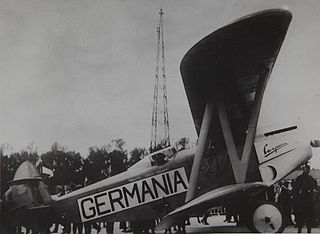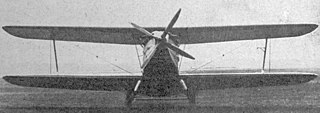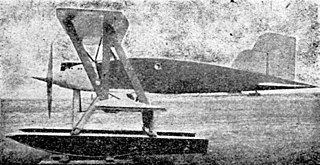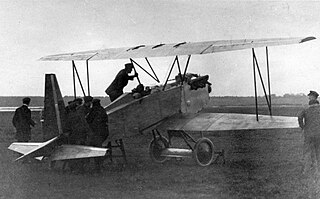
The Northrop C-19 Alpha was a series of three aircraft purchased from Northrop by the US Army Air Corps in 1931. They were slightly modified versions of the civil Northrop Alpha Type 2.
The IAR-825 Triumf is a Romanian-designed tandem multirole trainer aircraft based on the IAR-823 built for the Romanian Air Force. The aircraft is roughly in the same class with the Brazilian EMBRAER Tucano. The IAR-825 is equipped with the Canadian Pratt & Whitney Canada PT6 turboprop engine. The type's first flight took place on the 12 June 1982.

The Caspar C 32 was an aircraft developed in Germany for aerial spraying in the late 1920s. It was a single-bay biplane with staggered, equal-span wings that accommodated the pilot and a single passenger or observer in tandem open cockpits. A small, additional horizontal stabiliser was fitted near the top of the tall single tail fin above the main horizontal stabiliser.

The Caspar C 35 Priwall was a German airliner of the late 1920s, of which only a single example was built. It was a large, single-engine, single-bay biplane of conventional configuration with fixed tailskid undercarriage. The staggered, equal-span wings were braced with a large I-strut. Not only were the passengers seated within a fully enclosed cabin, but the flight deck was fully enclosed as well.

The Douglas DF was a commercial flying boat built by Douglas Aircraft Company, first flown on 24 September 1936.

The Horten H.III was a flying wing sailplane built by Walter and Reimar Horten in Germany from 1937 to 1944.
The Caspar C 36 was an aircraft developed in Germany for aerial reconnaissance in the late 1920s.
The Caspar C 23 was a German two-seat biplane sports aircraft that flew in 1925.
The Caspar C 24 was a German two-seat biplane sports aircraft that flew in 1925.

The Caspar C 26 was a sports aircraft developed in Germany in the mid-1920s.

The Caspar C 27 was a training seaplane aircraft developed in Germany in the late 1920s.

The Caspar C 29 was a 2-seat floatplane mail carrier and reconnaissance developed in Germany, but built by Dansk Aero in Denmark in the mid-1920s.
The Caspar C 33 was a training aircraft developed in Germany in the late 1920s.
The Caspar CT 1 was a sports aircraft developed in Germany in the early 1920s.
The Caspar U 2 was a recce floatplane built for Japan in the 1920s.

The Caspar CS 14 was a German military aircraft built in the 1920s. At first it was seen as a single seat fighter but was later modified to the reconnaissance role with a second seat.
The Caspar CLE 11 was a cantilever-parasol monoplane cabin airliner built and flown in Germany in 1923.
The Caspar CLE 16 was an airliner built in Germany in the early 1920s.
The Caspar CLE 12 was an airliner built in Germany in the early 1920s.
The IAR-831 Pelican is a Romanian trainer aircraft based on the IAR-825 built for the Romanian Air Force. One airframe was built, bearing the civil registration YR-IGA.









